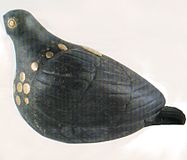Elam
Elam (/ˈiːləm/; Linear Elamite: ![]() hatamti; Cuneiform Elamite: 𒁹𒄬𒆷𒁶𒋾 ḫalatamti; Sumerian: 𒉏𒈠 elam; Akkadian: 𒉏𒈠𒆠 elamtu; Hebrew: עֵילָם ʿēlām; Old Persian: 𐎢𐎺𐎩 hūja)[1][2] was an ancient civilization centered in the far west and southwest of modern-day Iran, stretching from the lowlands of what is now Khuzestan and Ilam Province as well as a small part of southern Iraq. The modern name Elam stems from the Sumerian transliteration elam(a), along with the later Akkadian elamtu, and the Elamite haltamti. Elamite states were among the leading political forces of the Ancient Near East.[3] In classical literature, Elam was also known as Susiana (US: /ˌsuːʒiˈænə/ UK: /ˌsuːziˈɑːnə/; Ancient Greek: Σουσιανή Sousiānḗ), a name derived from its capital Susa.[4]
hatamti; Cuneiform Elamite: 𒁹𒄬𒆷𒁶𒋾 ḫalatamti; Sumerian: 𒉏𒈠 elam; Akkadian: 𒉏𒈠𒆠 elamtu; Hebrew: עֵילָם ʿēlām; Old Persian: 𐎢𐎺𐎩 hūja)[1][2] was an ancient civilization centered in the far west and southwest of modern-day Iran, stretching from the lowlands of what is now Khuzestan and Ilam Province as well as a small part of southern Iraq. The modern name Elam stems from the Sumerian transliteration elam(a), along with the later Akkadian elamtu, and the Elamite haltamti. Elamite states were among the leading political forces of the Ancient Near East.[3] In classical literature, Elam was also known as Susiana (US: /ˌsuːʒiˈænə/ UK: /ˌsuːziˈɑːnə/; Ancient Greek: Σουσιανή Sousiānḗ), a name derived from its capital Susa.[4]
Alternative names
Elam was part of the early urbanization of the Near East during the Chalcolithic period (Copper Age). The emergence of written records from around 3000 BC also parallels Sumerian history, where slightly earlier records have been found.[5][6] In the Old Elamite period (Middle Bronze Age), Elam consisted of kingdoms on the Iranian plateau, centered in Anshan, and from the mid-2nd millennium BC, it was centered in Susa in the Khuzestan lowlands.[7] Its culture played a crucial role during the Persian Achaemenid dynasty that succeeded Elam, when the Elamite language remained among those in official use. Elamite is generally considered a language isolate unrelated to any other languages. In accordance with geographical and archaeological matches, some historians argue that the Elamites comprise a large portion of the ancestors of the modern-day Lurs[8] whose language, Luri, split from Middle Persian.
Etymology[edit]
The Elamite language endonym of Elam as a country appears to have been Hatamti (![]() in Linear Elamite),[9][10] or Haltamti (Cuneiform Elamite: 𒁹𒄬𒆷𒁶𒋾 halatamti).[11]
in Linear Elamite),[9][10] or Haltamti (Cuneiform Elamite: 𒁹𒄬𒆷𒁶𒋾 halatamti).[11]
Exonyms included the Sumerian names ELAM.MAki𒉏𒈠𒆠 and ELAM, the Akkadian Elamû (masculine/neuter) and Elamītu (feminine) meant "resident of Susiana, Elamite".[12] The Sumerian term elam also referred to the highlands.[13]
In prehistory, Elam was centered primarily in modern Khuzestān and Ilam. The name Khuzestān is derived ultimately from Old Persian: 𐎢𐎺𐎩 (hūja) meaning Susa/Elam.[14] This became Middle Persian: 𐭧𐭥𐭰 (hūz) "Susiana", and in modern Persian: خوز (xuz), compounded with the toponymic suffix -stån "place".
The Assyrians had utterly destroyed the Elamite nation, but new polities emerged in the area after Assyrian power faded. Among the nations that benefited from the decline of the Assyrians were the Iranian tribes, whose presence around Lake Urmia to the north of Elam is attested from the 9th century BC in Assyrian texts. Some time after that region fell to Madius the Scythian (653 BC), Teispes, son of Achaemenes, conquered Elamite Anshan in the mid 7th century BC, forming a nucleus that would expand into the Persian Empire. They were largely regarded as vassals of the Assyrians, and the Medes, Mannaeans, and Persians paid tribute to Assyria from the 10th century BC until the death of Ashurbanipal in 627 BC. After his death, the Medes played a major role in the destruction of the weakened Assyrian Empire in 612 BC.
The rise of the Achaemenids in the 6th century BC brought an end to the existence of Elam as an independent political power "but not as a cultural entity" (Encyclopædia Iranica, Columbia University). Indigenous Elamite traditions, such as the use of the title "king of Anshan" by Cyrus the Great; the "Elamite robe" worn by Cambyses I of Anshan and seen on the famous winged genii at Pasargadae; some glyptic styles; the use of Elamite as the first of three official languages of the empire used in thousands of administrative texts found at Darius’ city of Persepolis; the continued worship of Elamite deities; and the persistence of Elamite religious personnel and cults supported by the crown, formed an essential part of the newly emerging Achaemenid culture in Persian Iran. The Elamites thus became the conduit by which achievements of the Mesopotamian civilizations were introduced to the tribes of the Iranian plateau.
Conversely, remnants of Elamite had "absorbed Iranian influences in both structure and vocabulary" by 500 BC,[110] suggesting a form of cultural continuity or fusion connecting the Elamite and the Persian periods.[111]
The name of "Elam" survived into the Hellenistic period and beyond. In its Greek form, Elymais, it emerges as designating a semi-independent state under Parthian suzerainty during the 2nd century BC to the early 3rd century AD. In Acts 2:8–9 in the New Testament, the language of the Elamitēs is one of the languages heard at the Pentecost. From 410 onwards Elam (Beth Huzaye) was the senior metropolitan province of the Church of the East, surviving into the 14th century. Indian Carmelite historian John Marshal has proposed that the root of Carmelite history in present day India could be traced to the promise of restoration of Elam (Jeremiah 49:39).[112]
In modern Iran, Ilam Province and Khuzestan Province are named after Elam civilization. Khuzestan means land of the Khuzis and Khuzi itself is a Middle Persian name for Elamites.[113]

![Elamite reliefs at Eshkaft-e Salman. The picture of a woman with dignity shows the importance of women in the Elamite era.[opinion]](http://upload.wikimedia.org/wikipedia/commons/thumb/9/9c/Eshkaft-e_Salman_II.jpg/200px-Eshkaft-e_Salman_II.jpg)